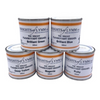Gold Leaf Across the World - Netherlands
- by Sam Wozniak
A Golden Legacy: The History and Uses of Gold Leaf in the Netherlands
Gold leaf — known in Dutch as bladgoud — has long played a significant role in the artistic, architectural, and cultural identity of the Netherlands. While often associated with Italian Renaissance or Baroque Spanish interiors, the Dutch have a quieter but no less fascinating tradition of gilding (Dutch: vergulden), which spans centuries and continues to influence restoration (restauratie) and design today.
Whether it’s 24 carat (24 karaat) gold on royal crests or 23.5 carat (23,5 karaat) gold leaf in 17th-century panel paintings, the Netherlands has woven goldleaf into its cultural fabric in both subtle and monumental ways.
Golden Beginnings: Gilding in the Dutch Golden Age
During the Dutch Golden Age (17th century), the Netherlands saw an explosion of wealth, trade, and artistic innovation. Although Dutch aesthetics were often more restrained than the opulence of their southern neighbours, gold leaf was still widely used in painting, woodwork, and decorative arts — particularly in framing and architectural details.
Artists like Rembrandt and Frans Hals frequently worked with gilded frames made with 23.5 carat gold leaf, applied by skilled artisans. These gilded frames not only protected the artwork but enhanced its perceived value and visual impact. In this era, gilding was often used to create contrast against the dark palettes typical of Dutch Baroque painting.
Monumental Applications in Churches and Palaces
Although the Dutch Protestant tradition favoured modesty, there were still monumental uses of gold leaf in civic and religious buildings — particularly those influenced by international styles. The interiors of royal residences, like the Paleis op de Dam in Amsterdam, display gilded woodwork, ceiling panels, and symbolic elements that represent the Dutch Republic’s power and wealth.
Churches such as the Nieuwe Kerk in Amsterdam or St. John's Cathedral in ‘s-Hertogenbosch feature elements of gilding in wood carvings, altarpieces, and pipe organs. These applications often used 23.5 carat gold leaf, which offered a balance between purity and durability, ideal for detailed, long-lasting ornamentation.
Modern Restoration and the Role of Goldleaf Today
Today, restoration efforts in the Netherlands often involve the careful application of goldleaf to preserve historical works and architecture. Whether restoring a 17th-century mirror frame, an antique cabinet, or gilded inscriptions on façades, 23.5 carat or 24 carat gold leaf is selected depending on the context and required durability.
Institutions like the Rijksmuseum in Amsterdam frequently oversee restoration projects involving gold leaf, particularly in preserving decorative arts and historical frames. Dutch craftspeople still train in traditional gilding (vergulden) techniques, including water gilding and oil gilding, ensuring that this centuries-old skill remains vibrant.
Beyond restoration, gold leaf is making a comeback in contemporary design and fine art. Dutch designers and visual artists incorporate 24 carat gold leaf for its luminous, symbolic qualities — often exploring themes of value, fragility, and legacy in a modern context.
Culinary and Decorative Innovations
Interestingly, gold leaf is also used in the Netherlands today for culinary and luxury decorative purposes. Edible gold leaf can be found in high-end restaurants in cities like Rotterdam and Amsterdam, where chefs apply 24 carat edible gold to elevate desserts, chocolates, and even cocktails.
Meanwhile, bespoke interior design firms use goldleaf in everything from gilded wallpaper patterns to ceiling details and signage — blending tradition with cutting-edge design.
Conclusion: The Enduring Brilliance of Dutch Gilding
The story of gold leaf in the Netherlands is one of quiet elegance, technical mastery, and enduring relevance. From the subtle glow of a 17th-century painting frame to the monumental gilded carvings in royal buildings, Dutch gilding traditions have left an indelible mark on art and architecture.
Whether used in restoration, monumental decoration, or bold modern art, the use of 23.5 carat and 24 carat gold leaf continues to reflect the Netherlands’ rich cultural heritage and its innovative creative spirit.






